ACURA NSX 1991 Service Repair Manual
Manufacturer: ACURA, Model Year: 1991, Model line: NSX, Model: ACURA NSX 1991Pages: 1640, PDF Size: 60.48 MB
Page 1571 of 1640
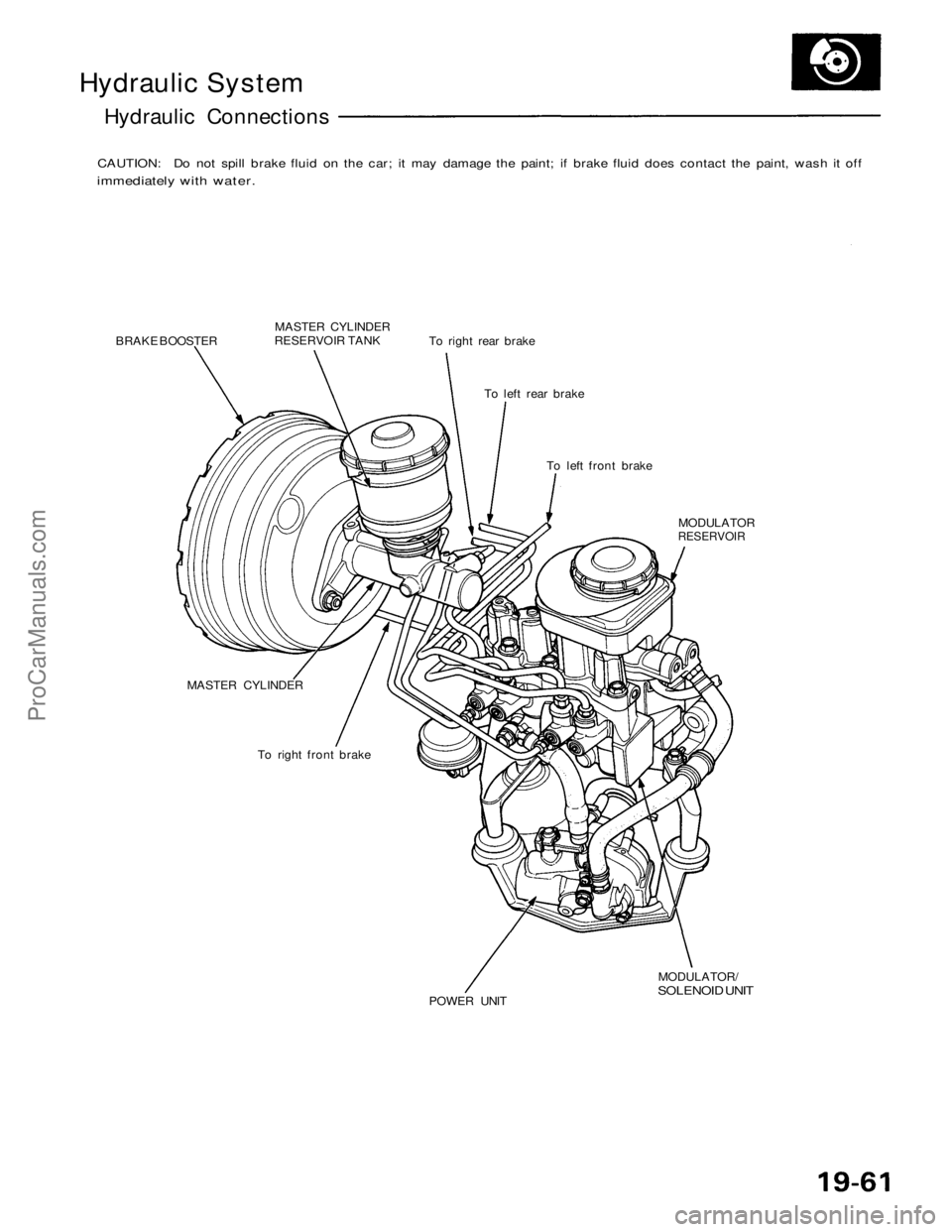
Hydraulic System
Hydraulic Connections
CAUTION: Do not spill brake fluid on the car; it may damage the paint; if brake fluid does contact the paint, wash it off
immediately with water.
BRAKE BOOSTER
MASTER CYLINDER
RESERVOIR TANK
To right rear brake
To left rear brake
To left front brake
MASTER CYLINDER
To right front brake
POWER UNIT
MODULATOR/
SOLENOID UNIT
MODULATOR
RESERVOIRProCarManuals.com
Page 1572 of 1640
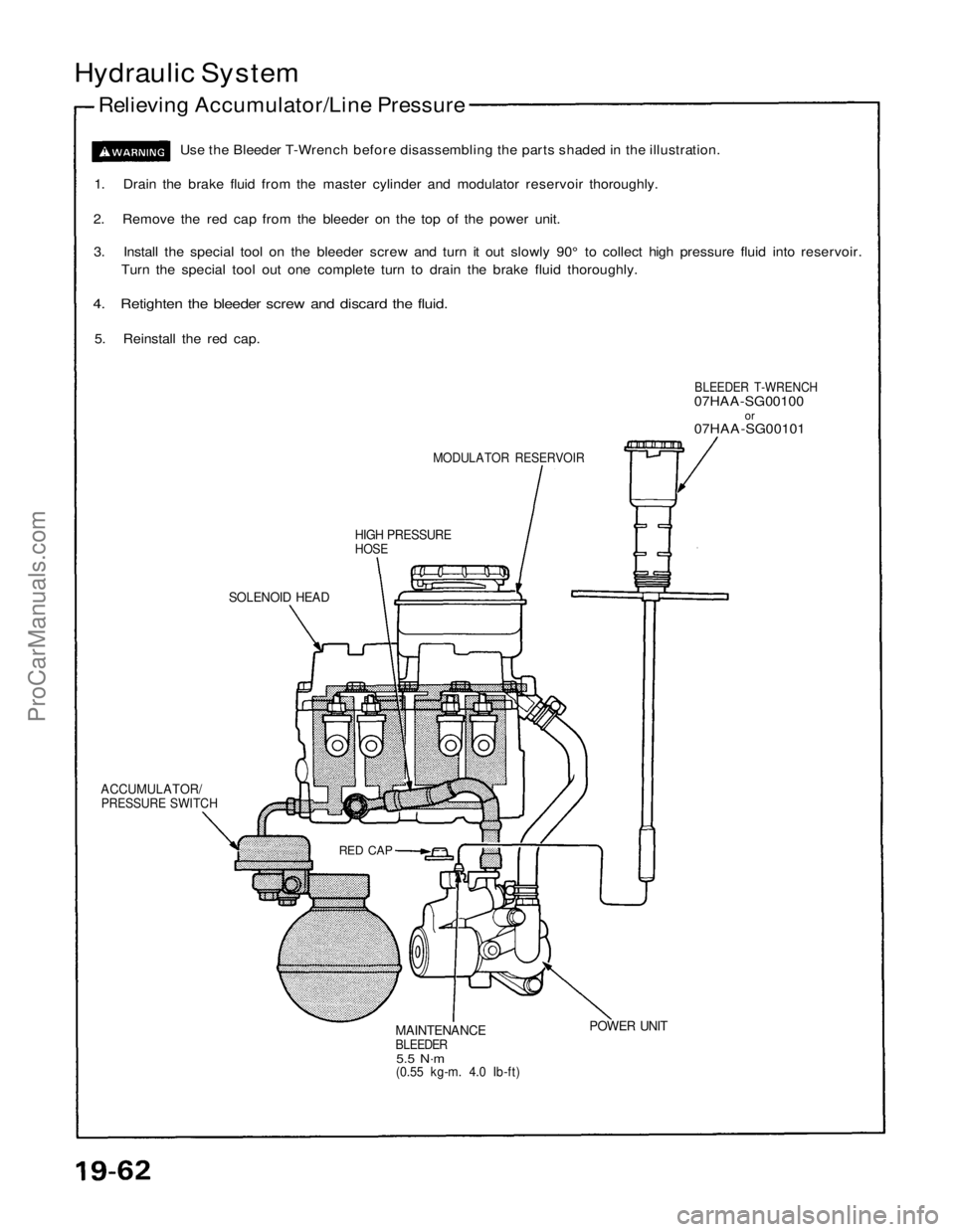
Hydraulic System
Relieving Accumulator/Line Pressure
Use the Bleeder T-Wrench before disassembling the parts shaded in the illustration.
1. Drain the brake fluid from the master cylinder and modulator reservoir thoroughly.
2. Remove the red cap from the bleeder on the top of the power unit.
3. Install the special tool on the bleeder screw and turn it out slowly 90° to collect high pressure fluid into reservoir.
Turn the special tool out one complete turn to drain the brake fluid thoroughly.
4. Retighten the bleeder screw and discard the fluid.
5. Reinstall the red cap.
MODULATOR RESERVOIR
HIGH PRESSURE
HOSE
BLEEDER T-WRENCH
07HAA-SG00100
or
07HAA-SG00101
SOLENOID HEAD
ACCUMULATOR/
PRESSURE SWITCH
RED CAP
MAINTENANCE
BLEEDER
5.5 N·m
(0.55 kg-m. 4.0 Ib-ft)
POWER UNITProCarManuals.com
Page 1573 of 1640
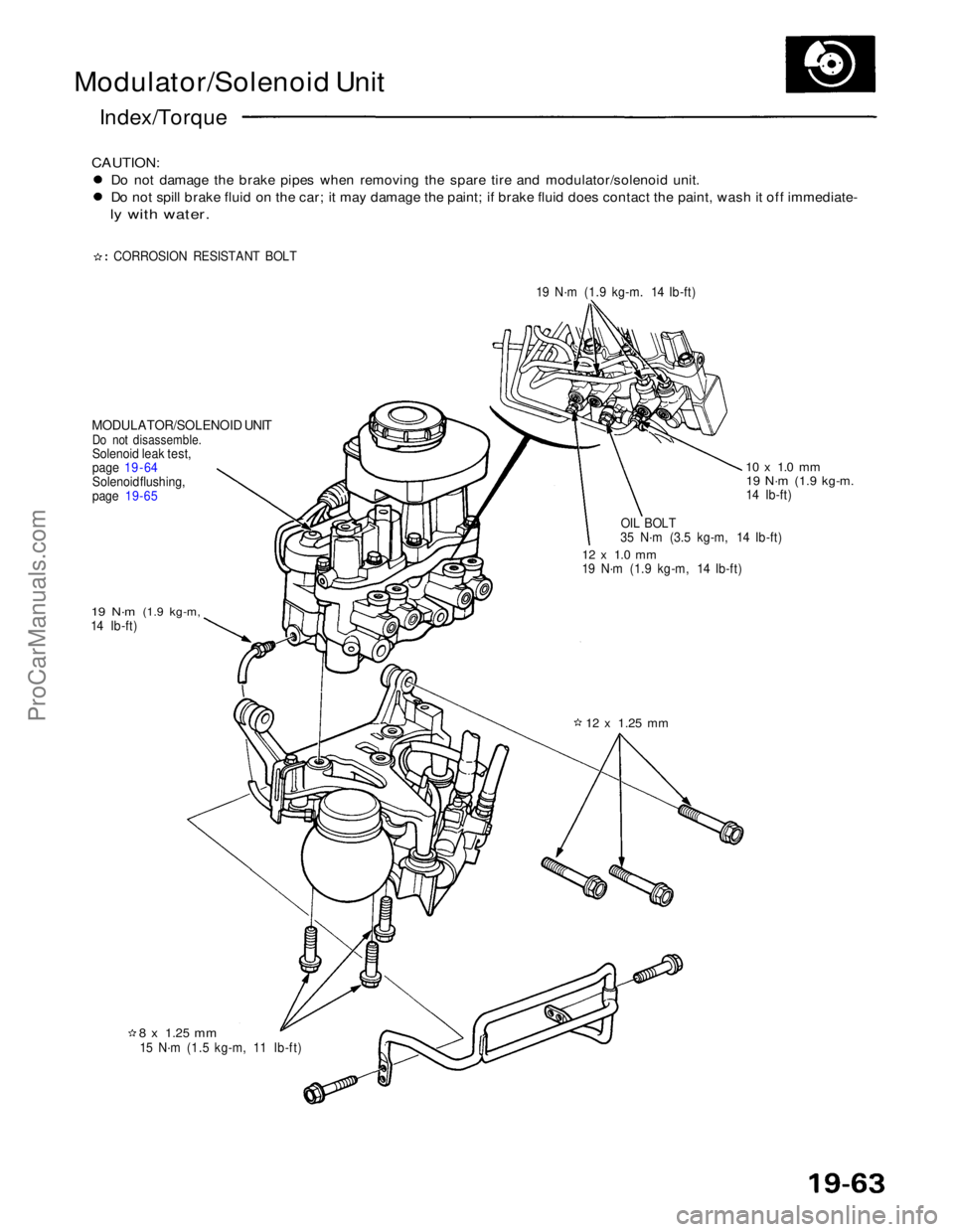
Modulator/Solenoid Unit
Index/Torque
CAUTION:
Do not damage the brake pipes when removing the spare tire and modulator/solenoid unit.
Do not spill brake fluid on the car; it may damage the paint; if brake fluid does contact the paint, wash it off immediate-
ly with water.
CORROSION RESISTANT BOLT 19 N·m (1.9 kg-m. 14 Ib-ft)
MODULATOR/SOLENOID UNIT
Do not disassemble.
Solenoid leak test,
page 19 - 64
Solenoid flushing,
page
19-65
19 N·m
(1.9 kg-m,
14 Ib-ft)
8 x
1.25
mm
15 N·m (1.5 kg-m, 11 Ib-ft)
12 x
1.25
mm
12 x 1.0 mm
19 N·m (1.9 kg-m, 14 Ib-ft)
OIL BOLT
35 N·m (3.5 kg-m, 14 Ib-ft)
10 x 1.0 mm
19 N·m
(1.9 kg-m.
14 Ib-ft)ProCarManuals.com
Page 1574 of 1640
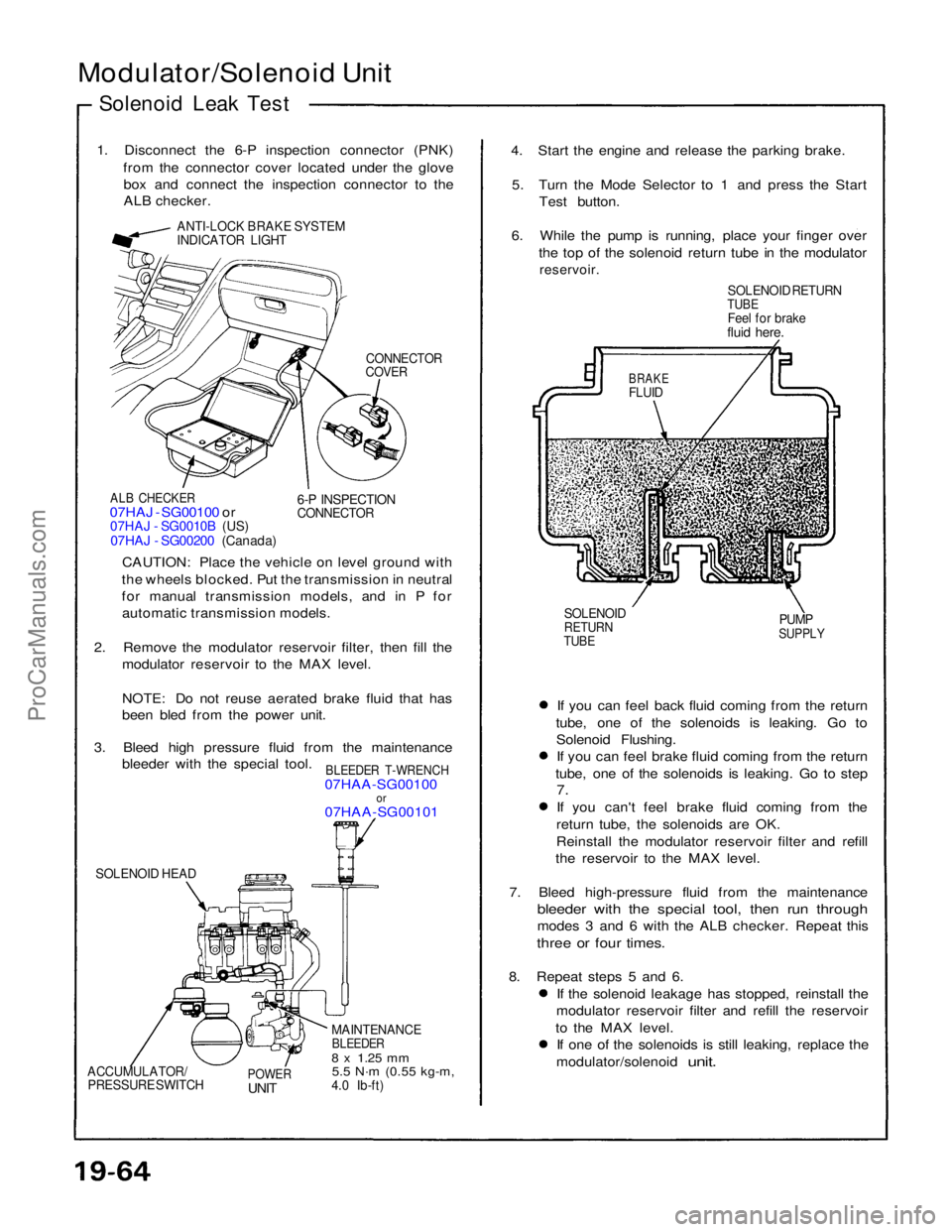
Modulator/Solenoid Unit
Solenoid Leak Test
1. Disconnect the 6-P inspection connector (PNK) from the connector cover located under the glovebox and connect the inspection connector to the
ALB checker.
ANTI-LOCK BRAKE SYSTEM
INDICATOR LIGHT
CONNECTOR
COVER
ALB CHECKER
07HAJ - SG00100 or
07HAJ - SG0010B (US)
07HAJ - SG00200 (Canada)
6-P INSPECTION
CONNECTOR
CAUTION: Place the vehicle on level ground with
the wheels blocked. Put the transmission in neutral
for manual transmission models, and in P for automatic transmission models.
2. Remove the modulator reservoir filter, then fill the modulator reservoir to the MAX level.
NOTE: Do not reuse aerated brake fluid that has
been bled from the power unit.
3. Bleed high pressure fluid from the maintenance bleeder with the special tool.
BLEEDER T-WRENCH
07HAA-SG00100
or
07HAA-SG00101
SOLENOID HEAD
MAINTENANCE
BLEEDER
8 x
1.25
mm
5.5 N·m
(0.55 kg-m,
4.0 Ib-ft)
POWER
UNIT
ACCUMULATOR/
PRESSURE SWITCH
If you can feel back fluid coming from the return
tube, one of the solenoids is leaking. Go to Solenoid Flushing.If you can feel brake fluid coming from the return
tube, one of the solenoids is leaking. Go to step
7.
If you can't feel brake fluid coming from the return tube, the solenoids are OK.
Reinstall the modulator reservoir filter and refill
the reservoir to the MAX level.
7. Bleed high-pressure fluid from the maintenance
bleeder with the special tool, then run through
modes 3 and 6 with the ALB checker. Repeat this
three or four times.
8. Repeat steps 5 and 6. If the solenoid leakage has stopped, reinstall the
modulator reservoir filter and refill the reservoir
to the MAX level. If one of the solenoids is still leaking, replace the
modulator/solenoid
unit.
SOLENOID
RETURN
TUBE
PUMP
SUPPLY
BRAKE
FLUID
SOLENOID RETURN
TUBE
Feel for brake
fluid here.
4. Start the engine and release the parking brake.
5. Turn the Mode Selector to 1 and press the Start Test button.
6. While the pump is running, place your finger over the top of the solenoid return tube in the modulator
reservoir.ProCarManuals.com
Page 1575 of 1640
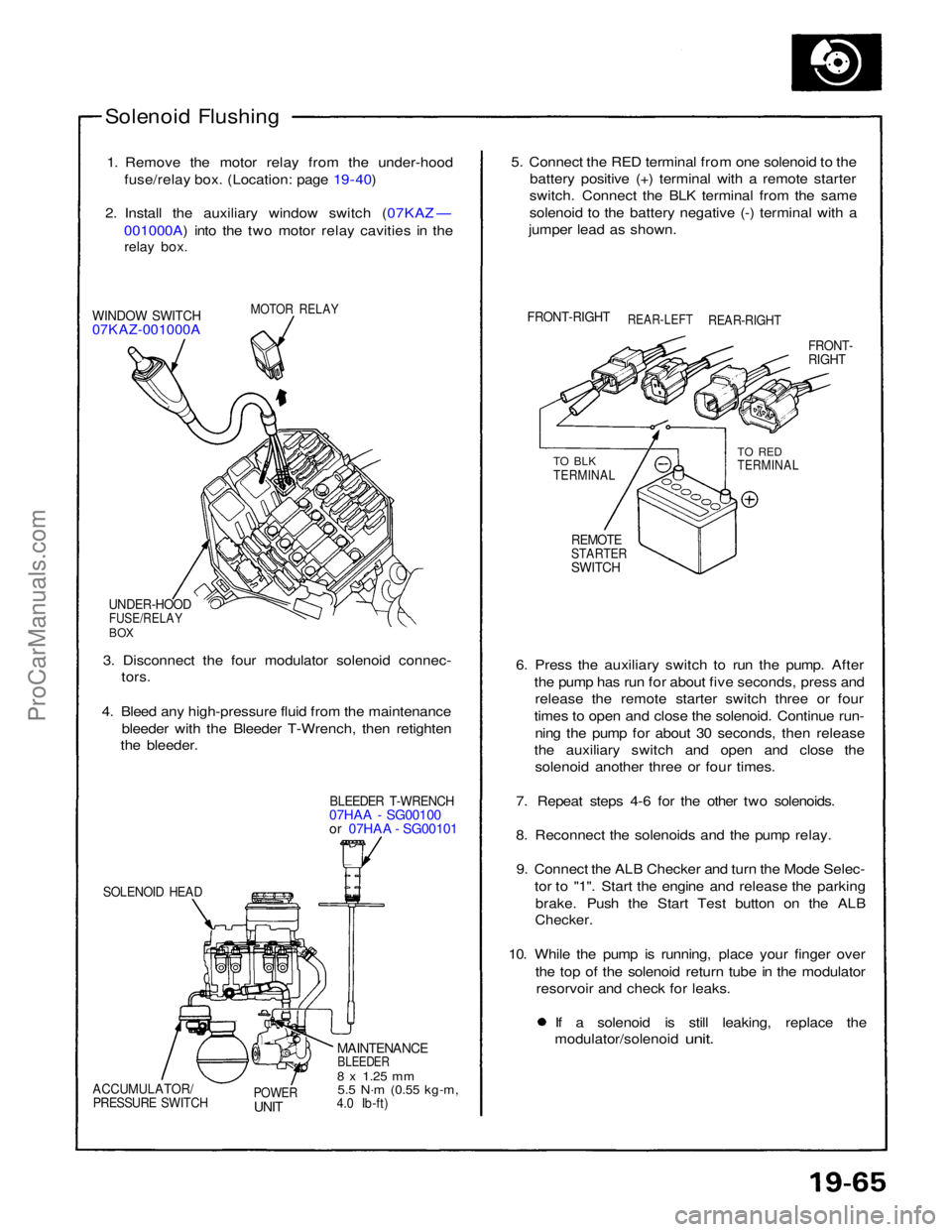
Solenoid Flushing
1. Remove the motor relay from the under-hood fuse/relay box. (Location: page 19 - 40)
2. Install the auxiliary window switch (07KAZ — 001000A) into the two motor relay cavities in the
relay box.
MOTOR RELAY
WINDOW SWITCH
07KAZ-001000A
UNDER-HOOD
FUSE/RELAY
BOX
3. Disconnect the four modulator solenoid connec- tors.
4. Bleed any high-pressure fluid from the maintenance bleeder with the Bleeder T-Wrench, then retighten
the bleeder.
BLEEDER T-WRENCH
07HAA - SG00100
or 07HAA - SG00101
SOLENOID HEAD
MAINTENANCE
BLEEDER
8 x
1.25
mm
5.5 N·m
(0.55 kg-m,
4.0 Ib-ft)
POWER
UNIT
ACCUMULATOR/
PRESSURE SWITCH
6. Press the auxiliary switch to run the pump. After
the pump has run for about five seconds, press andrelease the remote starter switch three or four
times to open and close the solenoid. Continue run- ning the pump for about 30 seconds, then release
the auxiliary switch and open and close the solenoid another three or four times.
7. Repeat steps 4-6 for the other two solenoids.
8. Reconnect the solenoids and the pump relay. 9. Connect the ALB Checker and turn the Mode Selec- tor to "1". Start the engine and release the parkingbrake. Push the Start Test button on the ALB
Checker.
10. While the pump is running, place your finger over the top of the solenoid return tube in the modulatorresorvoir and check for leaks. If a solenoid is still leaking, replace the
modulator/solenoid
unit.
REMOTE
STARTER
SWITCH
TO BLK
TERMINAL
TO RED
TERMINAL
FRONT-
RIGHT
FRONT-RIGHT
REAR-LEFT
REAR-RIGHT
5. Connect the RED terminal from one solenoid to the
battery positive (+) terminal with a remote starter
switch. Connect the BLK terminal from the same
solenoid to the battery negative (-) terminal with a
jumper lead as shown.ProCarManuals.com
Page 1576 of 1640
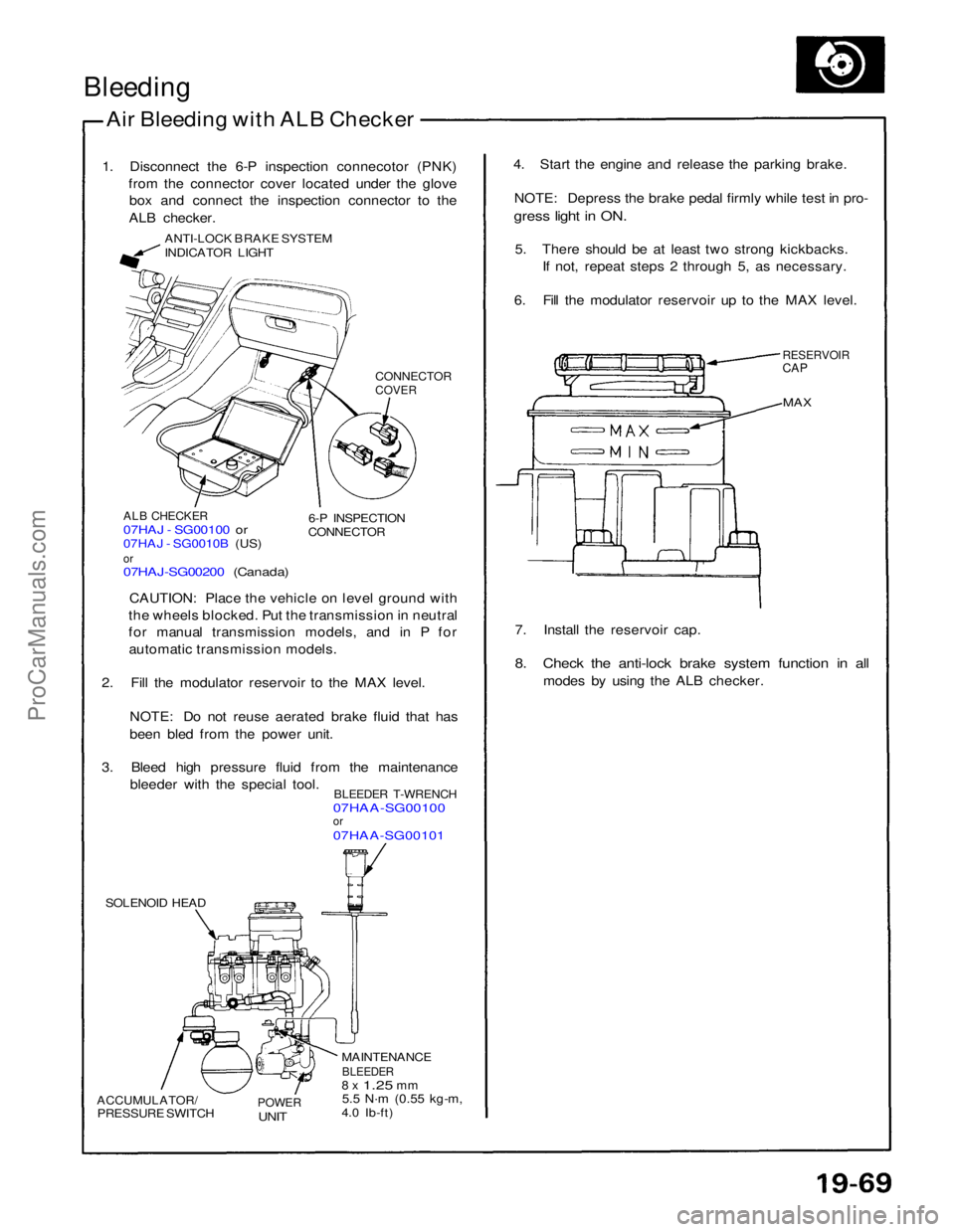
Bleeding
Air Bleeding with ALB Checker
1. Disconnect the 6-P inspection connecotor (PNK) from the connector cover located under the glovebox and connect the inspection connector to the
ALB checker.
ANTI-LOCK BRAKE SYSTEM
INDICATOR LIGHT
CONNECTOR
COVER
ALB CHECKER
07HAJ - SG00100 or
07HAJ - SG0010B (US)
or
07HAJ-SG00200 (Canada)
6-P INSPECTION
CONNECTOR
CAUTION: Place the vehicle on level ground with
the wheels blocked. Put the transmission in neutral
for manual transmission models, and in P for automatic transmission models.
2. Fill the modulator reservoir to the MAX level.
NOTE: Do not reuse aerated brake fluid that has
been bled from the power unit.
3. Bleed high pressure fluid from the maintenance bleeder with the special tool.
BLEEDER T-WRENCH
07HAA-SG00100
or
07HAA-SG00101
SOLENOID HEAD
ACCUMULATOR/
PRESSURE SWITCH
POWER
UNIT
MAINTENANCE
BLEEDER
8 x
1.25
mm
5.5 N·m
(0.55 kg-m,
4.0 Ib-ft) 7. Install the reservoir cap.
8. Check the anti-lock brake system function in all
modes by using the ALB checker.
MAX
RESERVOIR
CAP
4. Start the engine and release the parking brake.
NOTE: Depress the brake pedal firmly while test in pro-
gress light in ON.
5. There should be at least two strong kickbacks. If not, repeat steps 2 through 5, as necessary.
6. Fill the modulator reservoir up to the MAX level.ProCarManuals.com
Page 1577 of 1640
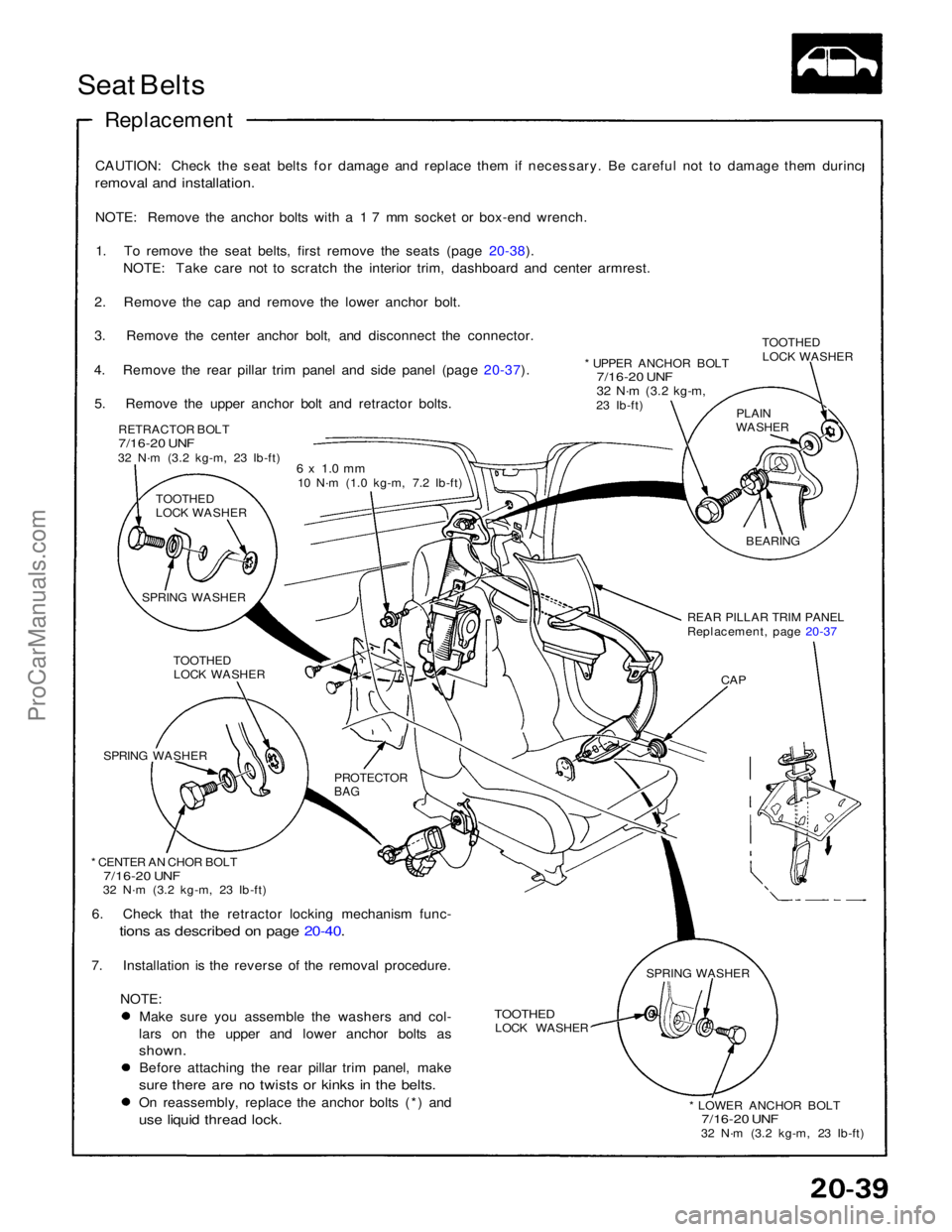
Seat Belts
Replacement
CAUTION: Check the seat belts for damage and replace them if necessary. Be careful not to damage them durinc
removal and installation.
NOTE: Remove the anchor bolts with a 1 7 mm socket or box-end wrench.1. To remove the seat belts, first remove the seats (page 20-38). NOTE: Take care not to scratch the interior trim, dashboard and center armrest.
2. Remove the cap and remove the lower anchor bolt.
3. Remove the center anchor bolt, and disconnect the connector.
4. Remove the rear pillar trim panel and side panel (page 20-37). 5. Remove the upper anchor bolt and retractor bolts. RETRACTOR BOLT
7/16-20 UNF
32 N·m (3.2 kg-m, 23 Ib-ft) 6 x 1.0 mm
10 N·m (1.0 kg-m, 7.2 Ib-ft)
TOOTHED
LOCK WASHER
SPRING WASHER TOOTHEDLOCK WASHER
SPRING WASHER
PROTECTOR
BAG
* CENTER AN CHOR BOLT
7/16-20 UNF
32 N·m (3.2 kg-m, 23 Ib-ft)
6. Check that the retractor locking mechanism func-
tions as described on page 20-40.
7. Installation is the reverse of the removal procedure.
NOTE:
Make sure you assemble the washers and col-
lars on the upper and lower anchor bolts as
shown.
Before attaching the rear pillar trim panel, make
sure there are no twists or kinks in the belts.
On reassembly, replace the anchor bolts (*) and
use liquid thread lock.
TOOTHED
LOCK WASHER
* LOWER ANCHOR BOLT
7/16-20 UNF
32 N·m (3.2 kg-m, 23 Ib-ft)
SPRING WASHER
CAP
REAR PILLAR TRIM PANEL
Replacement, page 20-37
BEARING
PLAIN
WASHER
* UPPER ANCHOR BOLT
7/16-20 UNF
32 N·m
(3.2 kg-m,
23 Ib-ft) TOOTHED
LOCK WASHERProCarManuals.com
Page 1578 of 1640
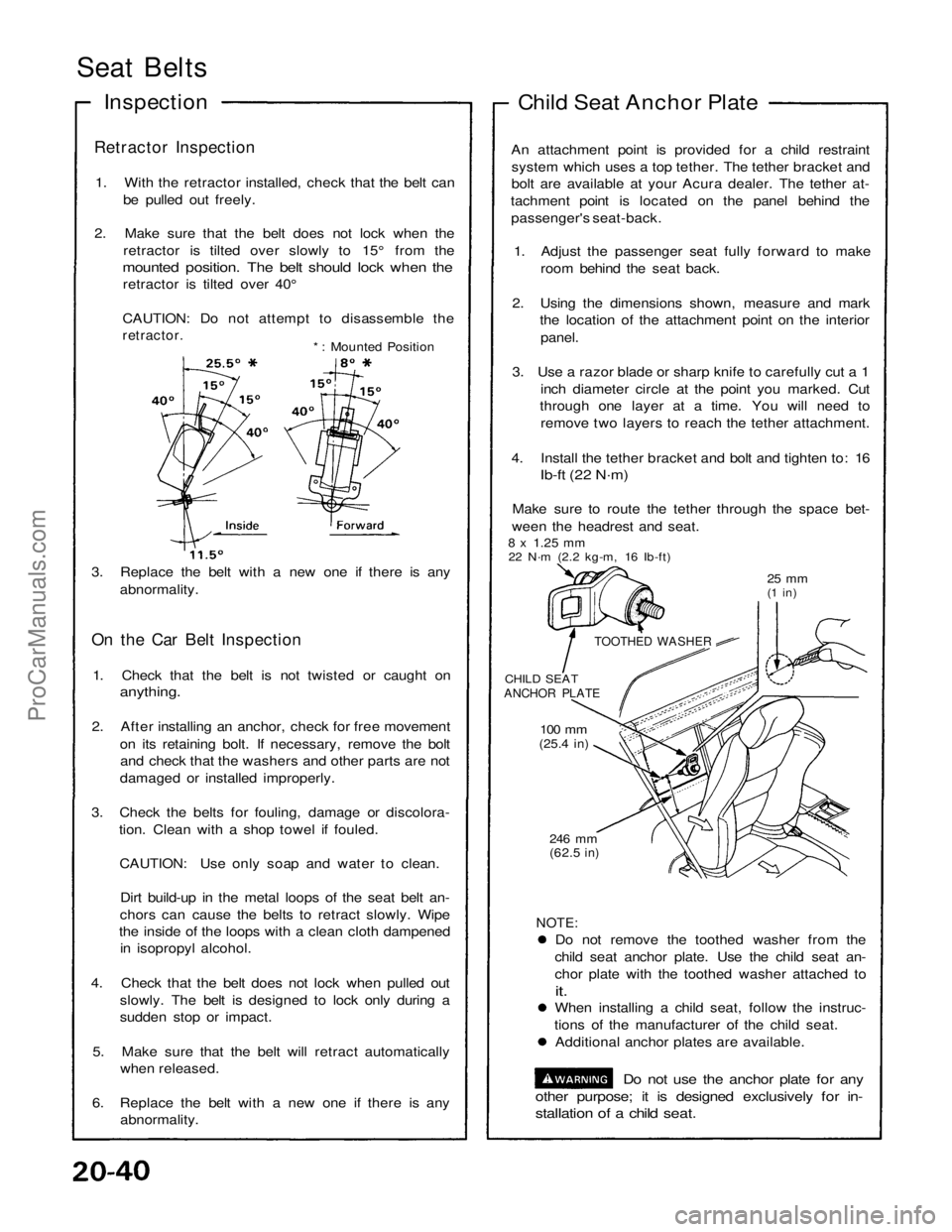
Seat Belts
Inspection
Retractor Inspection
1. With the retractor installed, check that the belt can be pulled out freely.
2. Make sure that the belt does not lock when the retractor is tilted over slowly to 15° from the
mounted position. The belt should lock when the
retractor is tilted over 40°
CAUTION: Do not attempt to disassemble the
retractor.
*: Mounted Position
3. Replace the belt with a new one if there is any abnormality.
On the Car Belt Inspection
1. Check that the belt is not twisted or caught on
anything.
2. After installing an anchor, check for free movement on its retaining bolt. If necessary, remove the boltand check that the washers and other parts are not
damaged or installed improperly.
3. Check the belts for fouling, damage or discolora- tion. Clean with a shop towel if fouled.
CAUTION: Use only soap and water to clean. Dirt build-up in the metal loops of the seat belt an-
chors can cause the belts to retract slowly. Wipe
the inside of the loops with a clean cloth dampened in isopropyl alcohol.
4. Check that the belt does not lock when pulled out slowly. The belt is designed to lock only during a
sudden stop or impact.
5. Make sure that the belt will retract automatically when released.
6. Replace the belt with a new one if there is any abnormality.
NOTE:
Do not remove the toothed washer from the
child seat anchor plate. Use the child seat an-
chor plate with the toothed washer attached to
it.
When installing a child seat, follow the instruc-
tions of the manufacturer of the child seat. Additional anchor plates are available.
Do not use the anchor plate for any
other purpose; it is designed exclusively for in-
stallation of a child seat.
246 mm
(62.5
in)
100 mm
(25.4
in)
CHILD SEAT
ANCHOR PLATE
TOOTHED WASHER
25 mm
(1 in)
8 x
1.25
mm
22 N·m (2.2 kg-m, 16 Ib-ft) An attachment point is provided for a child restraint
system which uses a top tether. The tether bracket and
bolt are available at your Acura dealer. The tether at-
tachment point is located on the panel behind the passenger's seat-back.
1. Adjust the passenger seat fully forward to make room behind the seat back.
2. Using the dimensions shown, measure and mark the location of the attachment point on the interior
panel.
3. Use a razor blade or sharp knife to carefully cut a 1 inch diameter circle at the point you marked. Cut
through one layer at a time. You will need to
remove two layers to reach the tether attachment.
4. Install the tether bracket and bolt and tighten to: 16
Ib-ft (22 N·m)
Make sure to route the tether through the space bet-
ween the headrest and seat. Child Seat Anchor PlateProCarManuals.com
Page 1579 of 1640
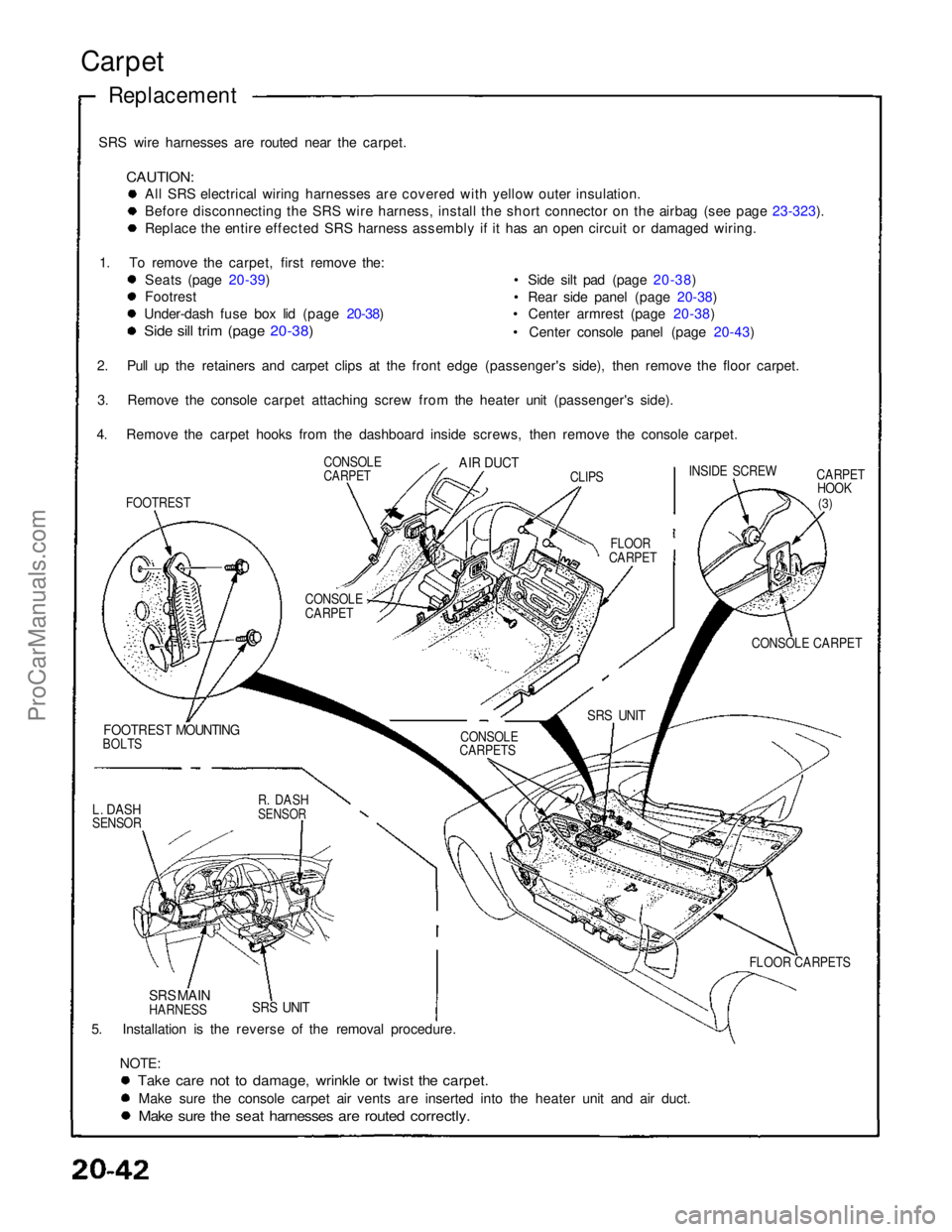
SRS wire harnesses are routed near the carpet.
CAUTION:
All SRS electrical wiring harnesses are covered with yellow outer insulation.
Before disconnecting the SRS wire harness, install the short connector on the airbag (see page 23-323).
Replace the entire effected SRS harness assembly if it has an open circuit or damaged wiring.
1. To remove the carpet, first remove the: Seats (page 20-39)
Footrest
Under-dash fuse box lid (page 20-38)
Side sill trim (page 20-38)
• Side silt pad (page 20-38)
• Rear side panel (page 20-38)
• Center armrest (page 20-38)
• Center console panel (page 20-43)
CARPETHOOK
(3)
CONSOLE CARPET
FOOTREST MOUNTING
BOLTS
5. Installation is the reverse of the removal procedure. NOTE:
Take care not to damage, wrinkle or twist the carpet.
Make sure the console carpet air vents are inserted into the heater unit and air duct.
Make sure the seat harnesses are routed correctly.
Carpet
Replacement
SRS UNIT
SRS MAIN
HARNESS FLOOR CARPETS
SRS UNIT
CONSOLE
CARPETS
CONSOLE
CARPET
FLOOR
CARPET INSIDE SCREW
CLIPS
AIR DUCT
CONSOLE
CARPET
FOOTREST
2. Pull up the retainers and carpet clips at the front edge (passenger's side), then remove the floor carpet.
3. Remove the console carpet attaching screw from the heater unit (passenger's side).
4. Remove the carpet hooks from the dashboard inside screws, then remove the console carpet.
L. DASH
SENSOR
R. DASH
SENSORProCarManuals.com
Page 1580 of 1640
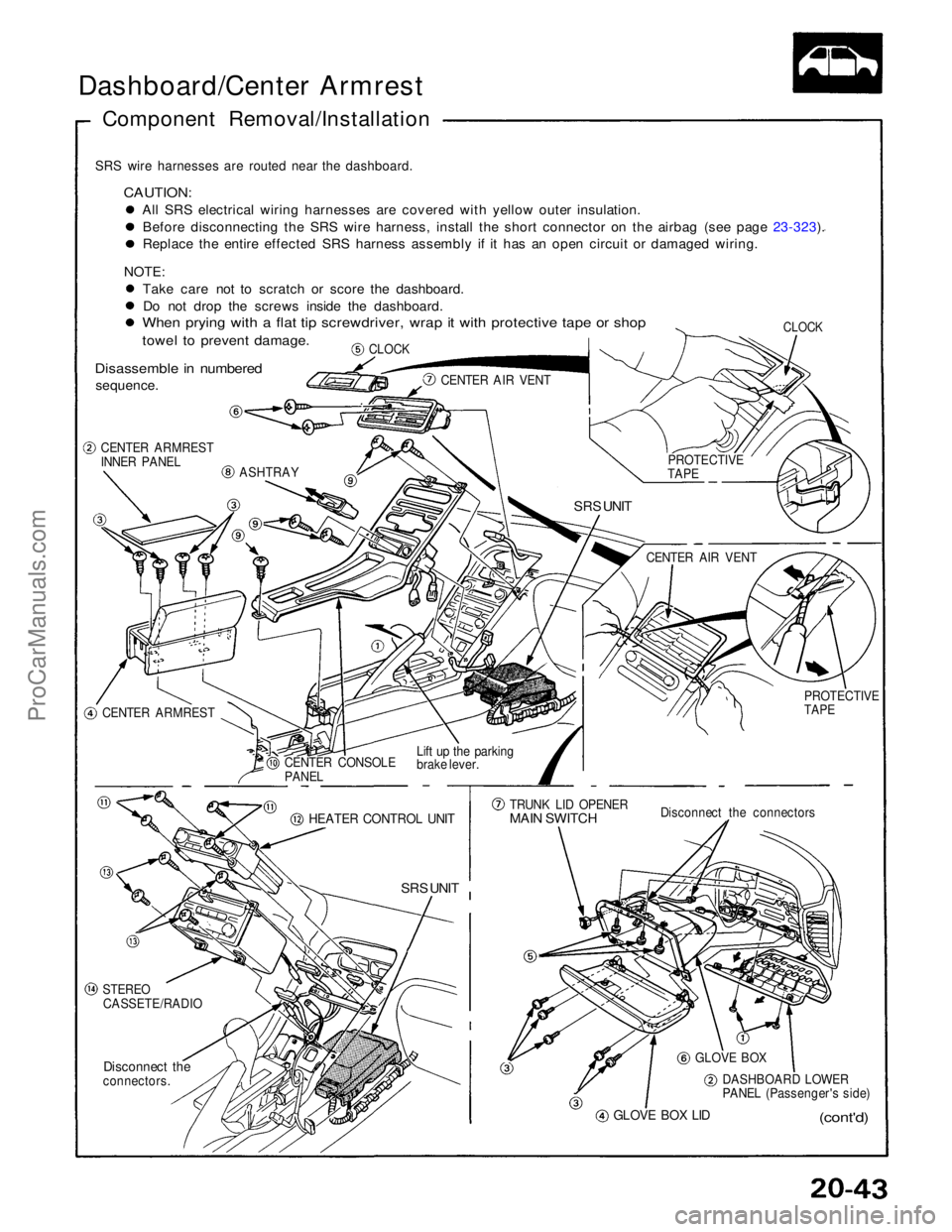
Dashboard/Center Armrest
Component Removal/Installation
SRS wire harnesses are routed near the dashboard.
CAUTION:
All SRS electrical wiring harnesses are covered with yellow outer insulation.Before disconnecting the SRS wire harness, install the short connector on the airbag (see page 23-323). Replace the entire effected SRS harness assembly if it has an open circuit or damaged wiring.
NOTE: Take care not to scratch or score the dashboard.Do not drop the screws inside the dashboard.
When prying with a flat tip screwdriver, wrap it with protective tape or shop
towel to prevent damage.
Disassemble in numbered
sequence.
CLOCK
CLOCK
CENTER AIR VENT
CENTER ARMREST
INNER PANEL
ASHTRAY
SRS UNIT
CENTER ARMREST CENTER CONSOLE
PANEL
Lift up the parking
brake lever.
HEATER CONTROL UNIT
SRS UNIT
STEREO
CASSETE/RADIO
Disconnect the
connectors.
GLOVE BOX LID
(cont'd)
DASHBOARD LOWER
PANEL (Passenger's side)
GLOVE BOX
Disconnect the connectors
TRUNK LID OPENER
MAIN SWITCH
PROTECTIVE
TAPE
CENTER AIR VENT
PROTECTIVE
TAPEProCarManuals.com